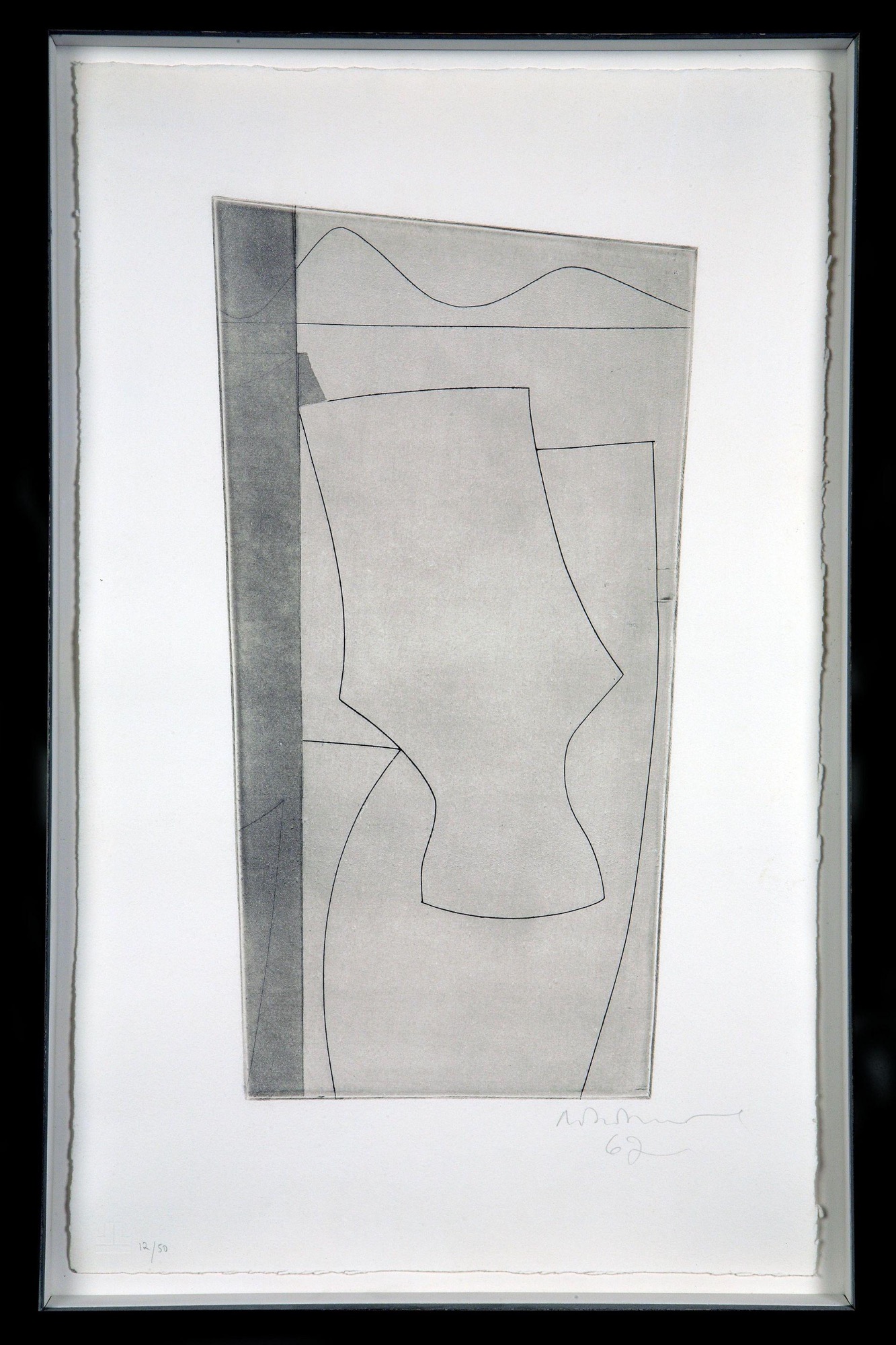Goblet Forms (Untitled)
10664
BEN NICHOLSON, O.M.,
(British 1894-1982)
Goblet Forms (Untitled)
Signed, dated 67 and numbered 12/50 in pencil
Etching & acquatint on pale cream wove paper. Excellent condition. Full margins (with the Lafranca blindstamp). L91. This work was published by Leslie Waddington Prints . Height 44.5 cm., 17½ in., Length 28 cm.,11in
In a 'Nicholson' box frame
BEN NICHOLSON (1894-1982)
Born in Denham, Buckinghamshire in 1894, Ben was the oldest son of the renowned artist Sir William Nicholson and Mabel Pryde, also a painter and sister of the artist James Pryde. Nicholson studied at the Slade School of Art, London between 1910-11 before travelling extensively through Europe and America from 1912 till 1918. During the latter part of these travels he began to concentrate on still-life painting and acknowledged the inspiration of his father.
'I owe a lot to my father-especially to his poetic idea and his still life theme. That didn't come from Cubism, but from my father'. From 1920 to 1931 he was married to the artist Winifred Nicholson, they lived in London and Cumberland, wintered in Castagnola, Switzerland and frequently visited Paris during their travels between England and Switzerland.
In 1921 Nicholson first saw a Cubist work by Picasso, which impressed him immensely, he stated, 'it was what seemed to me then completely abstract and in the centre there was an absolutely miraculous green-very deep, very potent and absolutely real'. He had his first solo show in 1922 at the Adelphi Gallery, London and soon afterwards began to create abstract works, influenced by Synthetic Cubism, which explored objects from different perspectives. This theme remained present throughout his career but he investigated it through different guises, such as within his graphic work, oil wash paintings and wooden reliefs he created of circles, squares and rectangles.
From 1926 Nicholson was chairman of the 7 & 5 society, an artistic group which saw itself as a forum for new ideas, members included Ivan Hitchens, Winifred Nicholson and Christopher Wood. Nicholson met Wood in 1926 and they exhibited together at Beaux Arts Gallery, London, in 1927, the year Nicholson began to adopt a primitive style of painting inspired by Henri Rousseau and early English folk art. During a trip to Cornwall in 1928 with Wood, they met Alfred Wallis whose forthright and naïve style encouraged Nicholson further in his aim to return to the basic fundamentals of drawing and painting.
From 1931 Nicholson lived in London, where he met Barbara Hepworth and Henry Moore. In 1932 he and Hepworth, who became his second wife in 1934, visited Picasso, Braque, Brancusi and Arp in Paris, further trips in 1933 and 1934 saw them meet Mondrian, Moholy-Nagy, Jean Helion and Auguste Herbin. The latter two encouraged Nicholson to join Abstraction-Creation, a group dedicated to promoting abstract art within differing styles. Nicholson's suitability for this group is shown by his 1930s work, with the multiple perspectives and flat picture plane of the 1932 painting, Au Chat Botte, which highlights his contact with Braque and his carved angular White Reliefs of 1933-8, which display the influence of both Hepworth and Mondrian. In 1937 Nicholson, alongside Naum Gabo and the architect Sir Leslie Martin, edited Circle: a monograph on Constructivist Art.
In 1934 Hepworth and Nicholson had triplets and in 1939 the family moved to Cornwall, which inspired Nicholson to add colour to his abstract reliefs and resume painting landscapes. The coloured reliefs gave way in 1945-6 to more linear abstract paintings. In 1951 he was commissioned to paint a mural for the Festival of Britain, the same year he and Hepworth divorced. In 1954 Nicholson represented Britain with a retrospective exhibition at the Venice Biennale, further retrospectives were held at the Tate Gallery, London in 1955 and 1969 and at the Stedelijk Museum, Amsterdam in 1955. In 1957 he married Felicitas Vogler, a photographer, and left Cornwall in 1958 for Ticino, Switzerland where he returned to creating painted reliefs, on a larger scale, inspired by the dramatic surroundings of Lake Maggiore and the Alpine landscape. Concurrently with these reliefs Nicholson executed drawings on white ground or paper tinted with light oil wash, as seen in the present work, etchings and drawings in which he reversed the etched plate and worked over the shallow relief-like embossment, the latter technique being displayed within Umber. Steven Nash's catalogue introduction for the retrospective exhibition of Nicholson's work at Albright-Knox Art Gallery, Buffalo in 1978 states of Nicholson's later works, 'Still life drawings are also numerous during this period and reach their farthest point of simplifications and abstraction. The familiar jugs and goblets provide points of departure for improvisations with exceedingly sparse, gossamer-like tracks of line, the gliding curves..and transparent weightlessness of which are the drawings' true subjects'.
In 1968 Nicholson was awarded the British Order of Merit, he moved to Cambridge in 1971, where his work can be seen at Kettles Yard Art Gallery alongside that of Alfred Wallis, Nicholson died in London in 1982.
British
Commemorative













